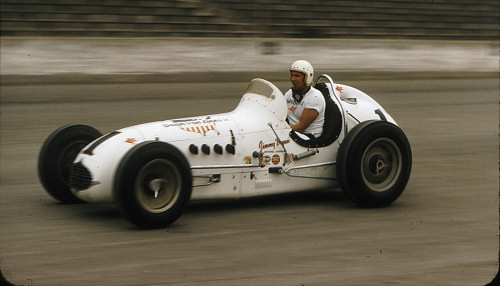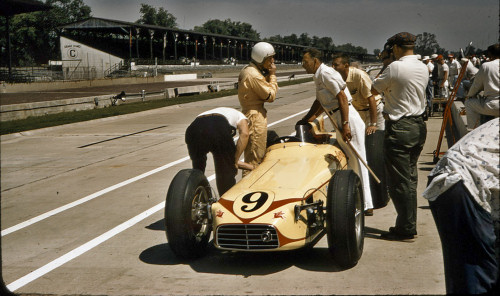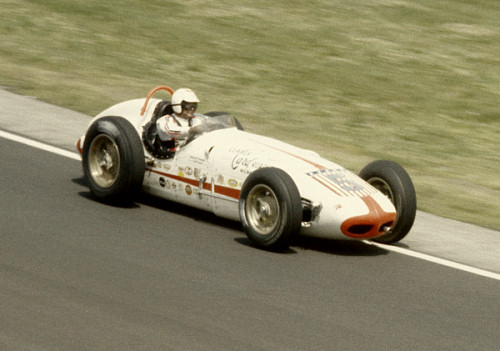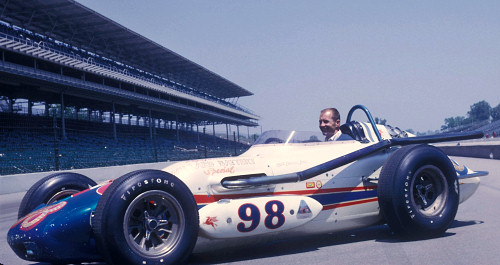The Way It Is/ Crescendo of the great Indy roadster eraby Gordon Kirby |
 From 1956-1964, the first nine years of USAC's quarter-century running Indy car racing, no fewer than six Indy 500s were won by Offy-powered roadsters built by A.J. Watson. Based in Glendale, California, Watson developed Frank Kurtis's theme to the next level. Watson passed away in 2014, aged 90, and always said his edge came from working regularly as a chief mechanic as he did throughout his long career.
From 1956-1964, the first nine years of USAC's quarter-century running Indy car racing, no fewer than six Indy 500s were won by Offy-powered roadsters built by A.J. Watson. Based in Glendale, California, Watson developed Frank Kurtis's theme to the next level. Watson passed away in 2014, aged 90, and always said his edge came from working regularly as a chief mechanic as he did throughout his long career.
Watson first went to Indianapolis in 1948. His cars failed to qualify in his first few attempts but his career took off in 1955 when he joined John Zink's team as chief mechanic and won two Indy 500s in 1955 and 1956. A lean man of few words who always wore a crew cut, Watson was a humble, hard-working man without an ounce of pretension. His cars were beautiful, fast and reliable and without doubt he personified the great roadster era. The leading teams from the last years of the AAA continued to set the pace in 1956 under USAC's new order. Bob Sweikert had won both the championship and Indy 500 in 1955 with John Zink's team which had first started racing Championship cars in 1950. A.J. Watson was Zink's chief mechanic and Watson built a new roadster for the 1956 season. Sweikert argued with Zink and left the team at the end of 1955 to join the DA Lubricants team so Zink hired Pat Flaherty who had scored his first Championship win at Milwaukee in 1955.  © Racemaker Press ~ Jimmy Bryan on the dirt in 1956 Russo escaped uninjured but he was the first of eight drivers who suffered tire failures in the 1956 500, including Sweikert, Jimmy Bryan and Tony Bettenhausen. After the race, many people in Gasoline Alley jokingly called the unfortunate affair 'The Voice of Firestone'. Flaherty had no such troubles however as he took the lead for good on lap 76 after battling with Pat O'Connor and Johnnie Parsons and never looked back, beating Sam Hanks's Kurtis 500C to the checkered flag by 20 seconds. Flaherty won again at Milwaukee two weeks later and finished fifth at Darlington and Atlanta in July but he crashed at Springfield in August and badly broke an arm. The injury sidelined Flaherty for two years and essentially brought an end to his career as he started only five races between 1958-1963 before retiring. Nor did the 1956 season smile on Bob Sweikert. The previous year's 500 winner finished sixth at Indy in 1956 and was third at Milwaukee but Sweikert was killed the following weekend in a sprint car race at Salem, IN after his car flew over the fence and somersaulted down an embankment before catching fire. As the season wore on it became clear that the only man who was going to beat the injured Flaherty to USAC's first championship was Jimmy Bryan. The cigar-smoking Arizonan joined Al Dean's Dean Van Lines team in 1954 and won that year's AAA Championship with chief mechanic Clint Brawner. Bryan and Dean's Brawner-prepared cars finished second to Sweikert in the 1955 AAA Championship. At Indianapolis in 1956, Bryan finished a distant nineteenth, a victim of two tire failures, but he won four races in the second half of the season--Springfield, Milwaukee, DuQuoin and the Hoosier 100--and added a pair of a seconds and a third place, thus taking his second championship. In 1957, Sam Hanks won the 500 driving George Salih's Belond Exhaust Special, the first of the 'lay-down' roadsters. Veteran chief mechanic Salih built the car with bodywork by Quin Epperly. Salih's concept was to install the car's Offy engine laid over at 18 degrees from horizontal in pursuit of a lower center of gravity and reduced wind resistance.  © Racemaker Press ~ Sam Hanks & George Salih in 1957 Hanks was a regular on the AAA circuit from 1951-1954, but ran only the Indy 500 in 1955, '56 and '57. He qualified Salih's 'laydown' in the middle of the field in 1957 and moved up quickly in the race, engaging in a furious battle with Paul Russo's Novi before pulling away as Russo's car began to handle poorly because of a broken chassis. Hanks dominated the last third of the race, winning by 21 seconds from Jim Rathmann's conventional, upright Epperly and Jimmy Bryan in Al Dean's Kuzma. Russo made it home in fourth place. In Victory Lane, Hanks announced he was retiring and walked arm in arm with his wife and friend Jimmy Bryan to Bryan's garage to celebrate his victory. The first of two 'Race of Two Worlds' run in Italy on the high-banked 2.6-mile Monza oval took place in 1957. The pair of Novis driven by Tony Bettenhausen and Russo were among ten USAC drivers invited to compete against the fastest cars the Europeans could scrape together and the spectacular Novis startled the Europeans. Bettenhausen qualified on the pole at 177.046 mph, setting a world closed course record, and Russo qualified second but blew his engine and didn't start the race. In the race, Bettenhausen led the opening laps but the rough track resulted in his car breaking first its throttle linkage, then its suspension and chassis. The winner at Monza was no less than Jimmy Bryan driving the Dean Van Lines Kuzma-Offy. Troy Ruttman finished second in John Zink's Watson-Offy and Johnnie Parsons was third in J.C. Agajanian's Kurtis-Offy. Bryan went on to take his third championship in 1957. He won in June at Detroit and Monza, which was a non-championship race, and finished the season with a flourish by taking second at Sacramento and winning the season-closer at Phoenix in November. He also finished second in September's Hoosier 100. At the end of the season Bryan decided he'd had his fill of dirt track racing. He didn't do any dirt racing in 1958 and signed with George Salih to drive the 1957 Indy-winning Belond Special at the Speedway and Monza in 1958. After a fierce battle at Indianapolis with the pair of similar Epperly 'laydowns' driven by Tony Bettenhausen and rookie George Amick, Bryan was able to take control and lead the last 75 laps. Bryan won the 500 by almost half a minute from Amick, Johnny Boyd and Bettenhausen, and a delighted Bryan couldn't resist smoking a cigar in victory lane. The only other race Bryan ran in 1958 was the second 'Race of Two Worlds' at Monza where he drove Salih's Belond Special to take second behind Jim Rathmann in John Zink's Watson.  © Racemaker Press ~ Rodger Ward at Indianapolis in 1959 USAC opened its 1959 season in April on the new, high-banked Daytona International Speedway. Amick qualified on the pole at 176.887 mph and the 40-lap, 100-mile was won by Jim Rathmann in Zink's Watson who battled with Rodger Ward before pulling away to win easily. But as Rathmann took the checkered flag, Amick crashed on the backstretch while fighting for third place. His car clipped the guardrail, flew into the air and flipped violently. Amick, 35, was killed instantly. A few weeks earlier NASCAR star Marshall Teague had been killed while testing an Indy car at the track and there would be no more Indy car races at Daytona after 1959. Meanwhile, a new star emerged that year in the shape of a reformed Rodger Ward with Bob Wilke's Leader Cards team. Milwaukee-based Leader Cards manufactured greeting cards and other paper products and Wilke bought his first race car--a midget--before WWII. He ran midgets successfully for many years before starting a USAC Championship team in 1958 with A.J. Watson as chief mechanic and car builder. For the 1959 season Wilke hired Ward to drive his car and it turned out to be a wise and very successful choice. Ward had made his first Indy 500 start in 1951 and scored his first AAA wins in 1953 at Springfield and Detroit. He drove for a variety of teams over the next few years, earning a reputation as a bit of a wild man who was prone to crashing cars and blowing engines. A turning point came in the middle of 1956 when he joined Roger Wolcott's team. Ward began to settle down and he won three races in 1957 at Milwaukee, Springfield and Sacramento followed by two more wins in 1958 at Milwaukee and Trenton. Aboard Bob Wilke's latest Watson-Offy, Ward started the 1959 season by finishing second at Daytona and he was second again at Trenton two weeks later. At Indianapolis he qualified sixth and raced through the opening stages of the 500 with polewinner Johnny Thomson and Jim Rathmann. But Thompson's car broke a torsion bar control link and he fell back as Ward pulled away to beat Rathmann by more than 20 seconds. Thompson hung on for third ahead of Tony Bettenhausen. Ward also won Milwaukee's 200-mile race in August with Watson's roadster and won the following week on the dirt at DuQuoin with the team's Watson dirt car. In September, he won the Hoosier 100 and was able to easily beat Bettenhausen to the championship. Ward also showed himself an adept road racer, competing with a midget in the first United States GP at Sebring at the end of 1959 and beating a field of Ferraris, Maseratis and Porsches with the midget in an SCCA race at Lime Rock that year. Over the next few years Ward, Watson and Leader Cards were the combination to beat. Ward battled for the USAC title with A.J. Foyt in 1960 and 1961, finished second at Indianapolis in 1960, third in 1961, and won both the 500 and the USAC title again in 1962. But at Indianapolis in 1960 Ward had to play second fiddle to Jim Rathmann who won the 500 aboard the Ken-Paul Watson after an epic battle with Ward.  © Racemaker Press ~ Foyt in victory circle in 1961 In 1959, driving the Simoniz Watson, Rathmann won the season-opener at Daytona and finished second at Indianapolis to Ward before scoring a superb win in the 1960 500 aboard the Ken-Paul Watson. Rathmann ran only two other races in 1960, at Milwaukee and Trenton, failing to finish both races because of brake problems. Ward bounced back to win at Milwaukee the week after Indianapolis but he was unable to win another race in 1960 and was beaten to the USAC Championship by A.J. Foyt who came on strong, winning four of the year's last six races. Foyt made his first USAC championship start in the summer of 1957 when he was twenty-two years old after making a name for himself in midgets and sprint cars. In 1958 he replaced Jimmy Bryan in the Dean Van Lines team and ran the next two seasons with Dean, collecting a couple of seconds and thirds on the dirt. For the 1960 season Foyt moved to the Bowes Seal Fast team where George Bignotti was chief mechanic. Bignotti was born in San Francisco and worked on midgets and sprint cars before breaking into Indy car racing in the mid-fifties. Bignotti's career took off in partnership with Foyt in 1960 and his cars ultimately would win seven Indy 500s and more than 80 Indy car races. Bignotti was Foyt's chief mechanic through most of 1960-1964 and the pair established themselves as the men to beat in Indy car racing in those years. In 1960, Foyt won four races in the year's second half aboard Bignotti's Meskowski-Offy dirt car, thus beating Ward to the first of a record seven USAC championships he would win over the following 20 years. Meanwhile, three-time champion Jimmy Bryan had gone into semi-retirement and ran only the Indy 500 in 1959 and 1960. But Ward refused to drive Wilke's dirt car at Langhorne in June because he considered the track too dangerous and Bryan therefore took up Wilke's offer to drive at Langhorne in place of Ward. He was out of shape and overweight but Bryan qualified second to Don Branson and tried to pass Branson for the lead on the opening lap as they raced through the notorious first turn, known as 'Puke Hollow'. Bryan lost control, flew into the air and rolled several times. He was alive when he was pulled from the wreckage but died on the way to the hospital. The 1961 season saw A.J. Foyt score his first Indy 500 victory aboard Bignotti's Watson/Trevis-Offy roadster after a famous battle with Eddie Sachs who had replaced Foyt in 1960 in the Dean Van Lines team. Foyt also beat Sachs to his second USAC championship that year. Foyt won on the dirt at Langhorne, DuQuoin and the Indiana State Fairgrounds (the Hoosier 100) while Sachs won both races at Trenton. Ward won at Milwaukee, Syracuse and Sacramento to finish third in points. Parnelli Jones made his Indy 500 debut in 1961, driving a Watson-Offy roadster for J.C. Agajanian, the renowned California car owner and Ascot race promoter who had watched Jones's rapid rise. Jones was recommended to Agajanian by 1951 and '58 AAA/USAC champion Tony Bettenhausen and Agajanian duly hired Parnelli for the 1961 season. At Indianapolis in 1961, Jones qualified fifth with his pal Hurtubise making the outside of the front row beside Don Branson and polewinner Eddie Sachs. Jones took it easy in the early laps, running fourth before shooting past Sachs, Ward and Rathmann in a single lap. The rookie led the race for 27 laps before a spark plug fouled and his engine eventually lost a cylinder.  © Racemaker Press ~ Parnelli with 'Calhoun' in 1963 Parnelli ran away with the race, leading 127 laps, but an exhaust header cracked and heat from the exhaust melted some tape retaining a brake line so that the brake line kept bumping up against the header which in turn wore a hole in the brake line. That made pit stops difficult and after running into his tires on his second stop he made it home in seventh place, running the full 200 laps. Meanwhile, Rodger Ward and Len Sutton scored a one-two sweep for Bob Wilke's Leader Card team. It was the high point of the team's reign at the pinnacle of the sport and the first time any team had finished one-two in the 500 since the Blue Crown team in 1947 and '48 with Mauri Rose and Bill Holland. Ward also beat Foyt to the championship in 1962. In addition to winning at Indianapolis, Ward won at Trenton, Milwaukee and Syracuse. Foyt also scored four wins at Trenton, Milwaukee, Langhorne and Sacramento, but Ward added a third place and a couple of fifths so that he was able to win the championship despite missing the year's last two races after breaking his back in an accident at Riverside aboard a sports car. Parnelli Jones dominated the Indy 500 once again in 1963, setting another new track record in qualifying and leading 167 laps to finally win the 500. Jim Clark finished second in his and the Lotus team's first Indy 500. The closing stages of the race were fraught with controversy as J.C. Agajanian and chief mechanic Johnny Poulsen argued energetically with chief steward Harlan Fengler to prevent Fengler from black-flagging Jones for leaking oil. But Parnelli didn't win again in 1963, suffering five DNFs from mechanical failures so that Foyt won the USAC title again in 1963. Both Foyt and Ward won five races in 1963 but Foyt also collected a couple of seconds and thirds, easily beating Ward to his third championship in four years. The following year Foyt won the Indy 500 a second time, but it turned out to be the last win for a front-engined roadster as 1963 and 1964 were the last years front-engine cars ruled the roost at the Speedway. A new order began to take shape in 1963 when Colin Chapman, Jim Clark and Dan Gurney arrived with their rear-engine Lotus-Fords. The rear-engine revolution at Indianapolis was coming fast in 1964 as Jim Clark qualified his Lotus 34-Ford on the pole and Bobby Marshman was second fastest in one of the previous year's Lotus 29s. The start of that year's 500 saw a fiery, multi-car accident which killed Eddie Sachs and Dave MacDonald, leaving a pall of black smoke hanging over the Speedway. It was one of the sport's worst days and many people called for automobile racing to be banned. USAC's response was to outlaw gasoline for 1965 in favor of alcohol. Fuel tank capacity was also restricted to 75 gallons and two mandatory pitstops were required for a 500-mile race. Pressurized refueling was also banned in 1965 and crushable fuel cells were specified like those built for aviation use in military helicopters. After a long delay the 1964 500 got going again. It wasn't long before Clark ran into tire trouble and Marshman got too low in the first turn, knocking-out his transmission drain plug and losing all its oil. That left Jones and Foyt to decide who would score the final Indy 500 victory for a front-engined car. But Parnelli's challenge vanished when his car caught fire during his last pitstop. He had to bail out, escaping with second and third degree burns to his left arm and legs. That was the last time Jones raced Agajanian's Watson-Offy roadster, known as 'Calhoun'. Later in the year, at Ford's request, Jones drove one of the rear-engine Lotus-Fords at Milwaukee and Trenton, winning both races. At Trenton, Jones beat Clark fair and square, but the rest of the 1964 season was all about Foyt who won the first seven races of the season and a record ten races in all to take his fourth title in five years. But times were changing fast. The great roadster era was over as the rear engine revolution was in full swing. 1965 would see the arrival of a new age in Indy car racing. |
|
Auto Racing ~ Gordon Kirby
Copyright ~ All Rights Reserved |
